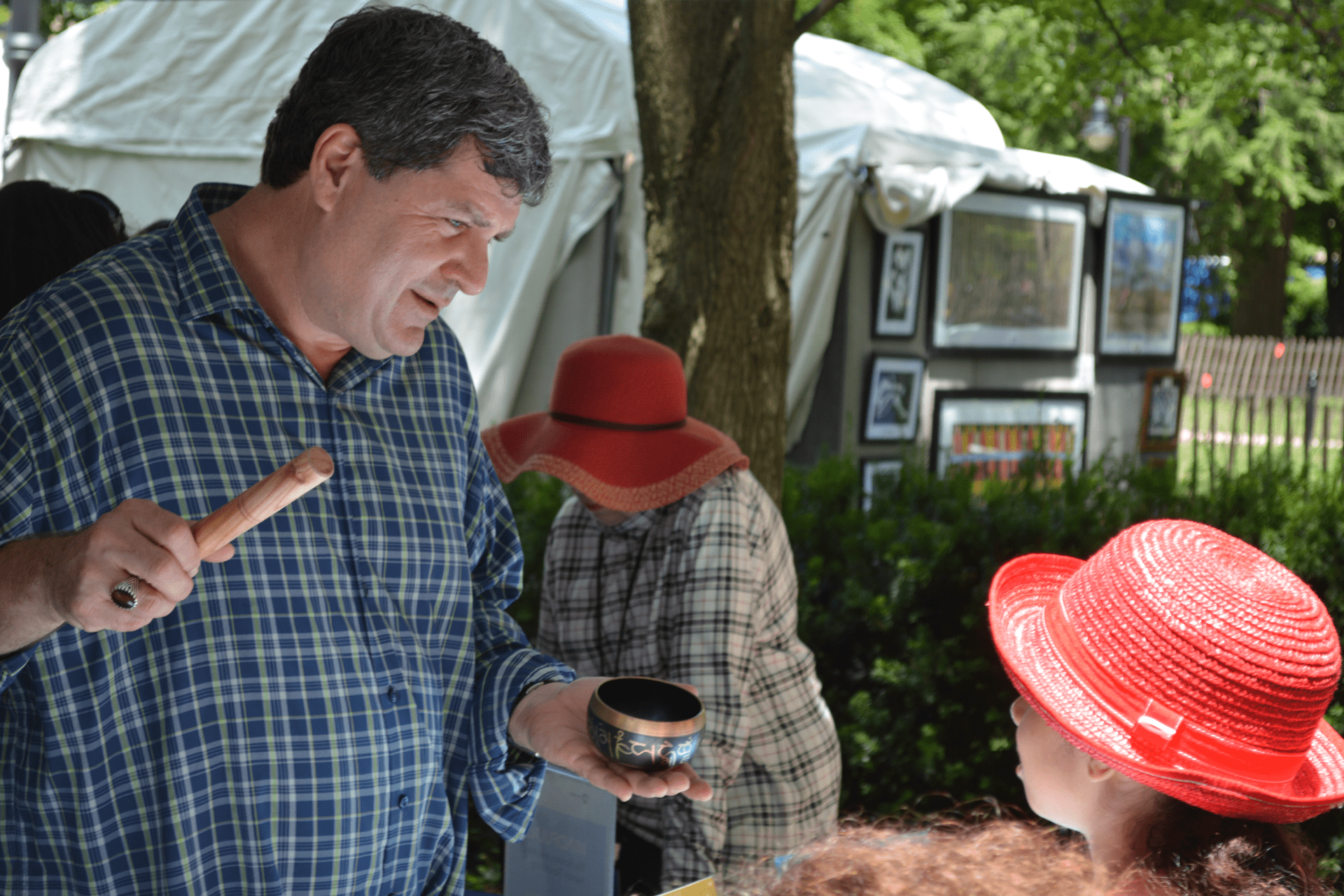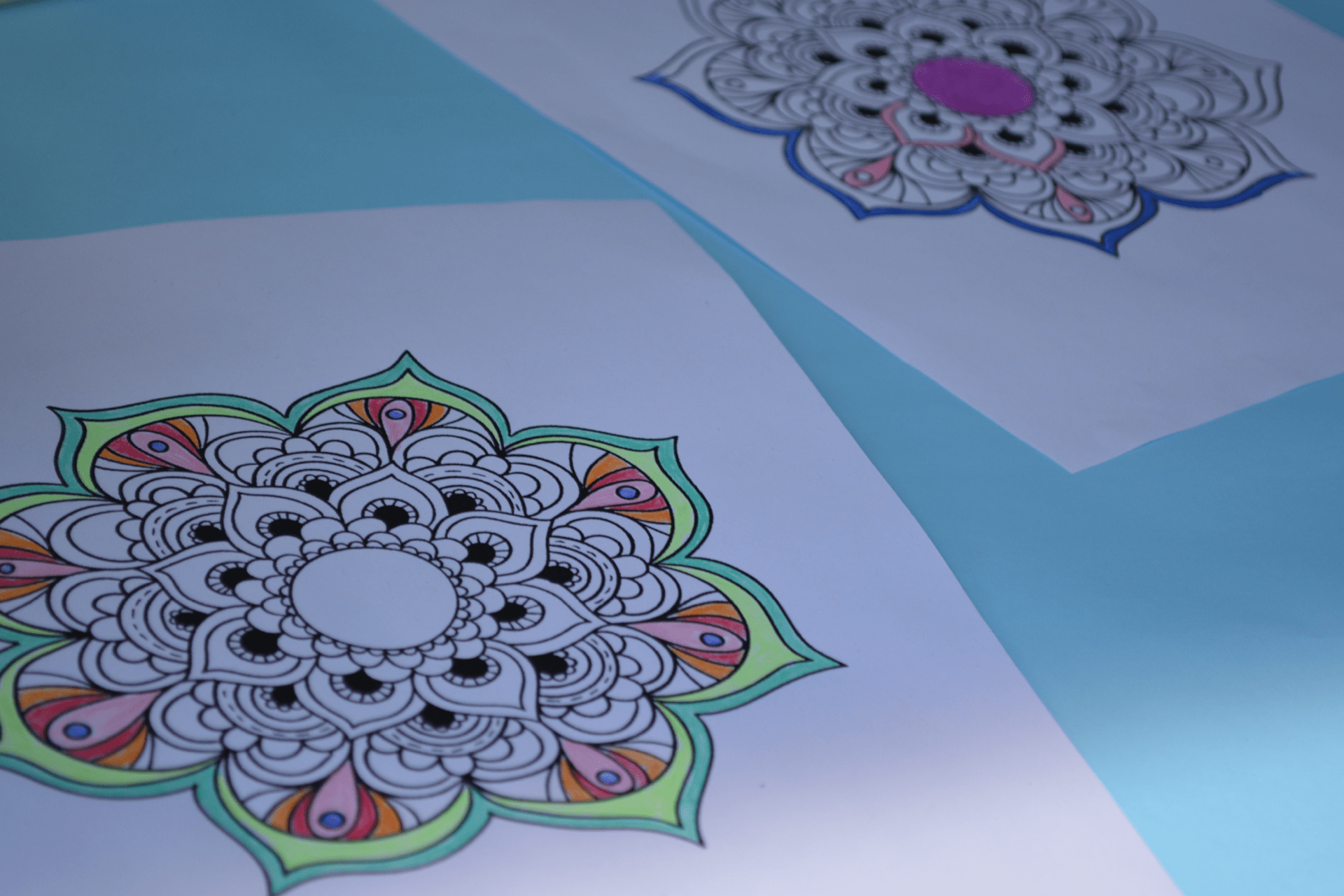
Teaching mindfulness to help navigate change
When thinking of mindfulness and compassion and why they are important, Robert Roeser, professor of human development and family studies and Bennett Pierce Professor of Care and Compassion, remembers a story he was told in India about two kinds of trees: the coconut tree and the mango tree.
The coconut tree grows tall, and its fruits are high up and out of reach. It doesn’t offer much shade to sit under, and it might even drop a coconut on your head. In contrast, the mango tree grows low and broad, and has many fruits among its branches. Birds can eat from the tree, and diverse families, children, and animals can find solace in its shade.
For Roeser, a person who practices mindfulness and compassion in their daily life is becoming like a mango tree, and the world needs more mango trees. Unfortunately, modern educational practices, from kindergarten through post-secondary education, are often designed to produce people who are like coconut trees.
“Mindfulness and compassion are about changing ourselves to become the kind of person who other people want to be around—the kind of person who makes space for others and shows them kindness, respect, attention, and empathy; the kind of person who isn’t always trying to assert personal views but can listen, and be curious and receptive,” said Roeser.
“By teaching students at all levels basic mindfulness and compassion techniques, we can start to create new generations of students with the attention, social-emotional maturity, and systems-thinking skills they will need to flourish. We can fundamentally impact the business decisions we make, the ways we raise our children and interact with our neighbors and community members, even how we plant our gardens. We can become like mango trees, changing ourselves and the environment around us in ways that contribute positively to the world.”

Author
Mary
Campbell
Breath Awareness
Body Scan
Sound - Silence
Transcripts
Breath Awareness
Begin by settling in, sitting comfortably but also feeling supported. And closing your eyes, or simply lowering your gaze down to the floor, and just simply checking in with the body for a moment, noticing what it feels like to simply sit, noticing that the only place is here and the only time is now. And we’re going to take a few deep breaths, but as we take these deep breaths, I invite you to use your mind’s voice to help guide these deep breaths. So as we breathe in, going ahead and seeing if you can count to six in your mind, allowing the inhale to last those six counts, and then seeing if we can allow the out-breath to last eight counts so that the out-breath becomes just a bit elongated, seeing if we can do two or three of those breaths. And then maintaining that same pace, seeing if you can now drop the count in your mind, and yet still maintaining that same rhythm of a long inhale and a bit longer exhale, just seeing if we can maintain that same pace now without the count. (silence)
And then seeing if we can even release that control that we have over the breath, allowing the breath to simply settle back into its natural pace, but perhaps this time, we’re just a little bit more aware of the movement of that air. So, again, just leaving a little bit of time for us to settle in on the natural rhythm of the breath. And you might find that as you’re doing this, your mind begins to wander, which is okay. It’s a natural thing that often happens. Just noticing whenever that happens, inviting our mind back to our breath, whenever that occurs. We’ll see if we can leave just a little bit more room of silence of noticing the inhale and exhale until we hear the sound of the bell. (silence)
Body Scan
Find a comfortable position with your feet flat on the floor. Your back straight, but not stiff. Your hands resting comfortably in your lap. Closing your eyes if that’s comfortable, or else just gazing downward toward the floor. Taking in a few long, deep breaths. Noticing each inhale and each exhale. Settling into this moment. Just bringing body and mind together.
Now, bringing your attention to the top of your head. Just noticing whatever it feels like right now. And moving down to your forehead, your cheeks, your jaw, the area around your eyes, your nose, and your mouth. And just breathing in relaxation and energy, and exhaling any fatigue or tightness or tension.
And now, moving down to your neck, your shoulders, and checking in with how that feels. Releasing any tightness and breathing in relaxation. Moving down both arms, noticing your upper arms, your elbows, your lower arms, your wrists, and each of your five fingers. Just noticing and letting go of any fatigue or tightness. Inhaling relaxation, inhaling energy.
And now, moving your attention to your chest and your belly. Perhaps feeling your belly and your chest rise with each inhale. Noticing that area deflate with each exhale. Shifting your attention to your back, your upper back, your lower back. Just noticing how that area feels. Filling the torso with air as you breathe deeply and noticing it deflate as you exhale.
Moving down to your hips, your sits bones. Noticing the support of the chair beneath your torso, your upper legs, your knees, your lower legs. And again, just noticing, releasing any tightness, and breathing in energy to that area of the body.
And now, noticing the ankles, the feet, the toes. Perhaps wiggling the toes and just noticing how they feel. Being aware of all that your feet do to support you each day. Breathing in air, energy, releasing any tightness or soreness in that area.
And now, scanning the whole body from the top of your head, through your torso, to the bottoms of your feet. Breathing in relaxation, breathing in energy. Letting go of any fatigue, any tiredness, any soreness. And just following your breath for a few more moments, until you hear the sound of the chime. (silence)
Focus on Sound-Silence Meditation
In this practice, we’ll try an external focus. We’re going to anchor out and pay attention to sounds and silence around us. So let’s begin by sitting in a comfortable position and closing your eyes if that is comfortable for you or gazing softly at the floor. And taking a few deep breaths to settle in. And let’s take a moment to set our intention for the next few minutes, intention to pay attention to the presence of sound and silence. So listen to sound and silence surrounding us.
And as we pay attention to sounds around us, you might notice that some sounds may be brief, they arise and then fall away. And other sounds may be continuous, remaining constant or changing as they go. So just listen to cells as they come and go. And there is no need to analyze them, just simply noticing. And there’s no good or bad sound and there’s no good or bad silence. So we are not clinging to the sounds or silence, we’re not rejecting sounds or silence, we’re just simply listening and noticing.
And if you notice silence or the presence of the absence of sound gently say to yourself, silence. When you notice a sound, gently say to yourself, sound. And if a sound continues, you can allow your awareness to soak into the sound and explore the sound for a few seconds. And this is different from analyzing the sound, you’re just simply feeling into the sound and whenever you’re ready you can zoom out again and come back to the sound space surrounding you. And continue monitoring and noticing a sound or silence. And this process repeats.
(silence)
If you become distracted by thoughts, feelings, or sensation, you have a choice to engage or not engage with thoughts, feelings, or sensations. In this practice, there’s no need to engage with them, so just simply let them go and gently bring your attention back to the sound space around you.
When you notice a sound, you may also notice your mind creating a picture or story about the sound, or you may notice a feeling or sensation in your body in response to a sound, that’s normal. But for now, there is also no need to engage with them so let them go, return to your focus and sound or silence.
(silence)
Now notice any sounds or silence coming from your left side.
Notice any sounds or silence coming from the right side.
(silence)
Notice any sounds or silence in front of you.
Now, behind you.
(silence)
Notice any sounds or silence above you.
And below you.
(silence)
Now pay attention to the entire sound space surrounding you and continue listening for sounds and silence, wherever they occur until you hear the bell.
(silence)
Starting young: Teaching mindfulness in K-12 schools
To understand the potential value of mindfulness and compassion training in education, Roeser and his research collaborators focus on so-called “windows of opportunity” during human development when introducing such techniques may be most beneficial: early childhood and the transition to elementary school, early adolescence and the transition to secondary school, and early adulthood and the transition to college or career.
“Our strengths and vulnerabilities show through most when we make a big life change. Major life transitions are thus times of significant change and growth. Prevention scientists have suggested that helping young people navigate these life changes using mindfulness and compassion practices has enduring impacts.”
Roeser began studying the effects of mindfulness education in pre-kindergarten through 12th grade schools while at Portland State University, and his research is still conducted in schools in the greater Portland area today. Roeser and his long-time collaborator Andrew Mashburn received a research grant to study the MindUP for Life curriculum and resources developed by The Goldie Hawn Foundation to support students transitioning to kindergarten.
Although the study has been disrupted by the pandemic, Roeser and Mashburn will eventually be able to see how this mindfulness-based, social-emotional learning program helps young children develop attention and self-regulation skills, as well as social skills like kindness, forgiveness, and mindful listening. As students in the study grow, Roeser and Mashburn will explore how well the students who received the MindUP program do academically, socially, and emotionally through the developmental transition to kindergarten and during their first year in school.
Supporting educators and schools
In addition to teaching mindfulness to the students, Roeser and his collaborators teach these same techniques to middle school teachers and provide resources to help them remain calm, clear, and kind in their daily classroom interactions with students. The researchers offered one group of teachers a 10-week mindfulness program—Mindfulness-Based Emotional Balance, developed by Margaret Cullen—and examined the program’s impacts on the teachers’ stress and wellbeing.
Although the program was designed primarily to improve teachers’ health and well-being—and there was evidence that it did—Roeser and his colleagues also examined and found evidence that teachers who engaged in the mindfulness program also showed improvements in their in-class behavior with students in their most stressful classroom.
“These practices not only helped them personally: they seemed to impact the frequency with which teachers interacted with students in developmentally appropriate ways,” said Roeser. “We saw that teachers were less reactive and punitive, and more proactive and autonomy-supportive in the ways they managed student behavior in their most stressful classrooms.”
Ultimately, it may be that teaching mindfulness in schools, to both students and teachers simultaneously, is the most advantageous approach to produce significant societal returns on investments in programming. Studies show that self-regulation and prosocial skills in early childhood are associated with lower unemployment, criminal activity, substance use, and mental health struggles later in life. Similarly, stress management and wellness for teachers may lead to less turnover, fewer absences and illnesses, and—not least—more effective teaching. Understanding how mindfulness programs in schools might contribute to these societal returns on investment remains a key part of this work going forward.
At the Art of Discovery booth at the 2019 Arts Festival, Roeser and members of the Department of Human Development and Family Studies, including Molly Countermine and Blake Colaianne, taught kids how to practice mindfulness and compassion with meditative glitter jars and mindfulness mandalas.
The Art and Science of Human Flourishing
As students progress from adolescence and young adulthood, Roeser and collaborators see another window of opportunity for engaging in contemplative practices like mindfulness and compassion: the transition to college.
The stress of moving from high school to college is considerable, and it is no secret that there is a mental health crisis on many college campuses today. As in early childhood and adolescence, research shows that young adults can derive tangible benefits from practices that help them live in the moment with awareness, acceptance, and kindness, as well as sharing their experience with others going through similar life transitions.
“Little children, because their memories haven’t developed to a certain extent, live in the here and now. They live in their senses and in their physical body much more than adults do. As we develop language and more abstract conceptual thinking, we start to live in the past and the possible future,” said Roeser. “These cognitive advances can also bring excessive rumination—instead of reflection—on the past and excessive worry—instead of planning—regarding the future. As we develop, we start to lose touch with our senses, our bodies, and our experience of the here and now. So we have to train ourselves to come back to the present moment and our senses to integrate these different ways of being.”
The demands of the transition to college led the Student Flourishing Initiative to create a new course for first-year college students, The Art and Science of Human Flourishing. The course—developed as a collaboration between researchers at Penn State, the University of Virginia, and the University of Wisconsin—teaches students about the concept of human flourishing, and perhaps more importantly, how to cultivate self-regulation and prosocial skills through mindfulness and compassion practices that can support their transitions into and through college.
Roeser and collaborators’ research evidence suggests that the course cultivates a number of positive coping skills, including attention skills like mindfulness, emotional skills like resiliency, and social skills like empathy and compassion. Students also feel less anxious and depressed and more joy and connection after the course—what Roeser considers flourishing—by utilizing the skills they learn. A study during the COVID-19 pandemic shows that students taking the course were coping better than the control group 6 to 18 months after they had taken the course.
Time
You may find that doing the practice at the same time is the most beneficial for your schedule—perhaps early in the morning or before bed at night.
Place
Find a quiet place
Ideally the best place to practice is a space where you feel safe, secure, and is free from distraction. However, there will never be a perfectly quiet space for practice, so making space for ambient sounds that can occur during your meditation is important. Rather than fight with such sounds, see if you can accept them as being present and return to the practice.
Practice Mindfulness
Position
Meditation can be practiced sitting, standing, lying, or walking.
Patience
Be patient with yourself
Remember that we are working from a baseline of the human mind that is distracted by thoughts, sensations, and feelings and that naturally wanders to the past and to the future.
How to practice mindfulness
To begin implementing mindfulness practices into daily life, Roeser suggests adding mindful awareness to our daily routines—a present-focused, open, and curious approach to the tasks we already do each day. Mindful walking, mindful listening, mindful eating, mindfulness to the changing seasons, even mindful bathing, are all ways to focus on the here and now, and gradually cultivate a more awakened approach to our lives and the people in it. Encouraging ourselves to stay in the moment with a curious and accepting attitude is the key. He also recommends making time in one’s day for a guided meditation.
Take a moment and try mindfulness of sound and silence, a favorite meditative technique of Roeser’s. Sit wherever you are in a comfortable position with your spine straight. You can keep your eyes open or closed. Focus on the sounds that are happening around your body to the right, left, front, back, above, and below yourself. Notice how silence may also exist in these directions. Try to let the sounds and silence be as they are, don’t try to change them, tune them out, push them away, or engage with them. Just take a few moments to notice and rest in the sound and silence around you. After this mindful pause, go on with your life.
Finding time for moments like this to pause, breathe, and let things be is the first step to integrating mindfulness into one’s daily life. When we make time for mindfulness and compassion, we become more like a mango tree, supporting and respecting not only ourselves, but providing comfort and nourishment to those in the world around us.
Photo Credits and Citations
Images: Tree branches borchee via Getty Images
Clouds roman-sigaev via Getty Images
Guided Audio Meditations: Courtesy of the Edna Bennett Pierce Prevention Research Center at Penn State

Author
Mary Campbell
Discover More
Research Impact
No Results Found
The posts you requested could not be found. Try changing your module settings or create some new posts.
In the News
No Results Found
The posts you requested could not be found. Try changing your module settings or create some new posts.
Student Experience
No Results Found
The posts you requested could not be found. Try changing your module settings or create some new posts.
Health Disparities
No Results Found
The posts you requested could not be found. Try changing your module settings or create some new posts.



